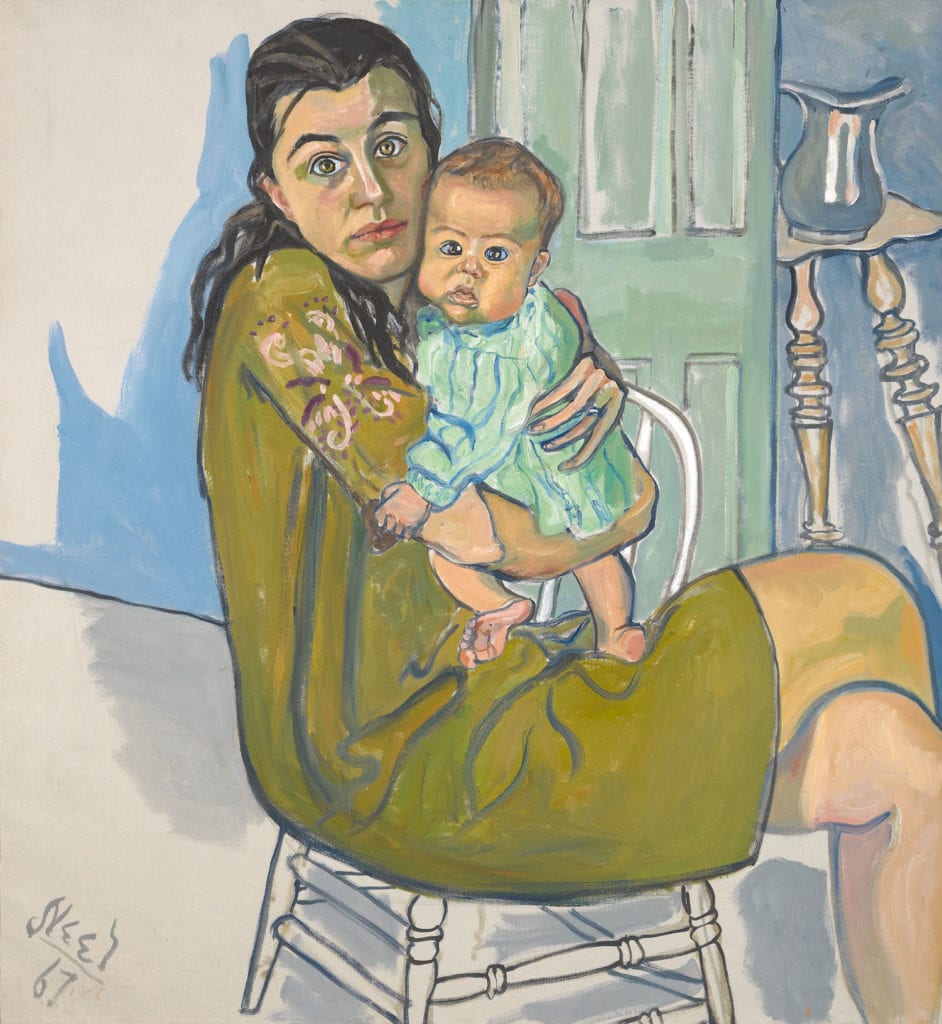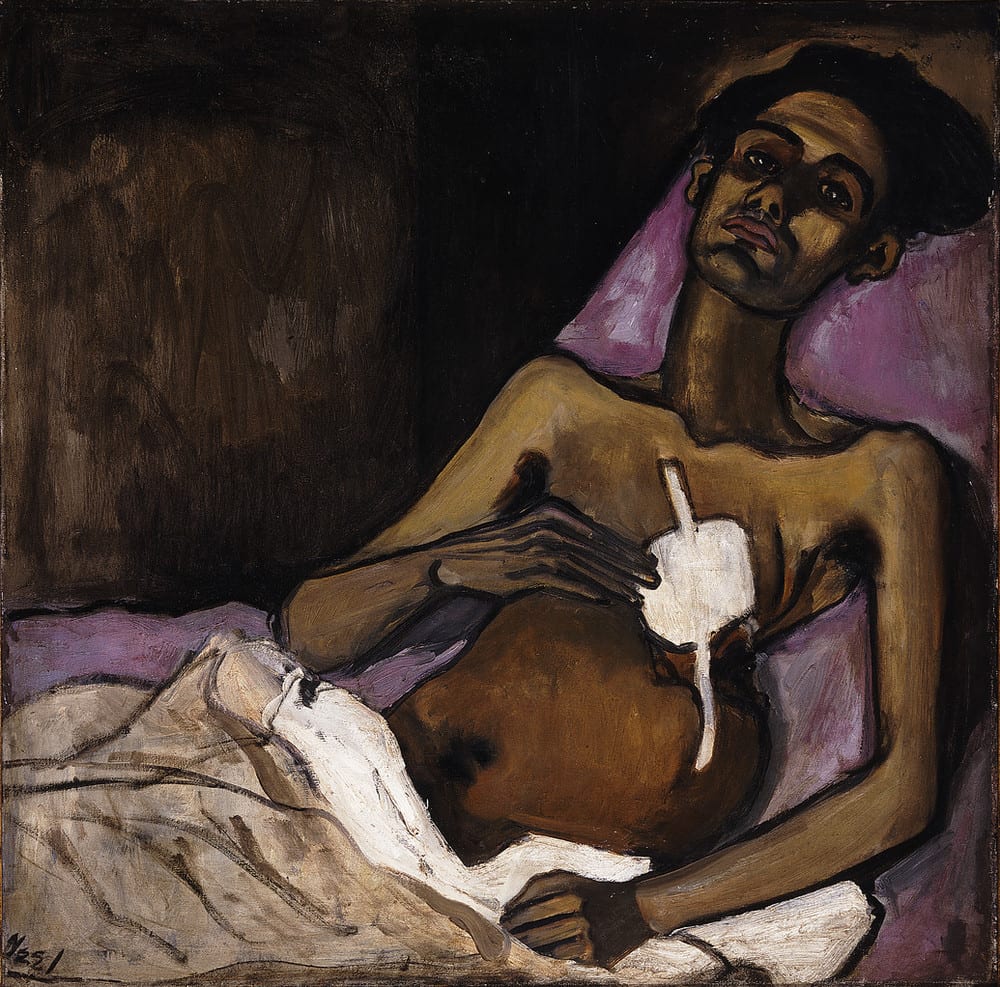Alice Neel at the Met
By • April 13, 2021 2 3085

Alice Neel isn’t the only woman artist with a self-portrait in the National Portrait Gallery. Among the others are Elaine de Kooning — whose famous portrait of JFK is in the America’s Presidents section — and the Louises: Bourgeois and Nevelson.
But apart from Ana Mendieta’s four-minute film, Neel’s is the only such work that shows the subject nude. And Neel completed hers at age 80, entirely without self-flattery.
Only six years before, in 1974, she had gone from anonymity — working in New York apartments filled to the brim with paintings of relatives, lovers, friends and neighbors — to admiration when the Whitney Museum of American Art gave her a solo show. One of her best-known works, the stunning 1970 portrait of Andy Warhol with scars bared, is in the Whitney’s collection.
Now considered one of the greatest American artists, man or woman, of the 20th century, Neel does not yet have the name recognition of, say, Frida Kahlo, who also painted in a representational manner and whose work makes a similar assault on the viewer. A new retrospective at the Metropolitan Museum of Art (open with timed ticketing) is the most recent move in that direction.
“Alice Neel: People Come First” presents close to 100 works in Neel’s signature style, bringing to mind van Gogh and Soutine. Part chronological and part thematic, the show, curated by Kelly Baum and Randall Griffey, runs through Aug. 1.
Underlining the link to van Gogh, in a section called Art as History, a Neel mother and child is paired with “Madame Roulin with Her Baby.” Like van Gogh’s, Neel’s paint is thick and her colors bright. The seemingly awkward proportions of her figures echo those in the van Gogh painting, but Neel was far from a self-taught folk or visionary artist.
A student at what is now Moore College of Art in Philadelphia, winning prizes for her drawing and painting, she chose to paint in her own version of Post-Impressionism or Expressionism. In some ways, Neel’s work is a continuation of the Ashcan School, which aimed to portray rough subjects in a rough manner. Ashcan School founder Robert Henri had taught at Moore (then called the Philadelphia School of Design for Women) before Neel’s time, but his approach, preserved in his 1923 book “The Art Spirit,” remained influential.
Due to her Philadelphia training and her many depictions of mothers with children, Neel is sometimes bracketed with Mary Cassatt, born more than 50 years earlier. In the exhibition’s Motherhood section are nine paintings, a watercolor and an ink drawing. Neel’s style, however, contrasts so sharply with that of the upper-class Cassatt — who studied at the more traditional Philadelphia Academy of the Fine Arts and later joined the Impressionists — that she has been called the “anti-Cassatt.”
Rejecting her middle-class upbringing, Neel married a Cuban painter, Carlos Enríquez, who was rebelling against his affluent background. From that point on, for decades, her life was marked by personal tragedy and what most would call domestic chaos.
During the Depression, she was active with left-wing artist groups and painted for the Federal Art Project. Living in New York, often in poverty, institutionalized for suicide attempts, raising two sons in the midst of conflicting relationships with men and investigated by the FBI for involvement with the Communist Party, Neel maintained an extraordinary will to paint. With the rise of Abstract Expressionism in the late 1940s and its dominance through the early ’60s, she did so mostly in obscurity.
The Met exhibition feels at times like a large come-as-you-are dinner party (almost in the Judy Chicago sense) with dozens of Neel’s subjects. In the early sections, some of the people staring back at you are prominent leftists or off the streets of Greenwich Village or Spanish Harlem; her painting “T.B. Harlem” of 1940, from the collection of the National Museum of Women in the Arts, shows the brother of José Santiago, the Puerto Rican father of her older son, after surgery for tuberculosis.
In later sections, Neel’s palette lightens and she is less concerned with background details, portraying artists, critics, gay and trans couples and other members of New York’s “downtown” scene.
The show concludes with a section called The Nude, displaying seven paintings including Neel’s self-depiction in old age, flesh sagging in a striped chair that appears in other portraits, a paintbrush in one hand and a rag in the other; a full-frontal male odalisque of curator John Perrault; and several male-female couples, tending to focus on the woman. Around the corner is “Pregnant Maria” of 1964, the first in her series of taboo-breaking paintings of nude pregnant women.
When she died in 1984, Neel had basked in a decade of recognition and, to some extent, celebrity. She intrigued Terry Gross and teased Johnny Carson. Neel was widely credited with being a forerunner of feminism, a movement she more or less repudiated, and of figurative painting’s revival. Abstraction was not for her, though “dividing up the canvas,” in her words, and color, obviously, were essentials of her craft. At least as important were getting at a subject’s character and, again in her words, the “zeitgeist” or “human comedy,” which, in Neel’s case as in Balzac’s, left no part of society unexposed.

“T.B. Harlem,” 1940. Alice Neel. Courtesy National Museum of Women in the Arts.


What awful art work!!! How embarrassing to represent women painters. She is a cartoonist.
Wow, this is sad…you need more than eyes to see and get this expression of art, darling! Be proud, my dear, ’cause life is many times more real than “beautiful”, and this woman shows exactly that.